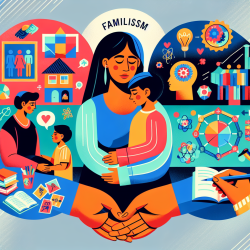Introduction
In the evolving landscape of U.S. demographics, Latinx families have emerged as a significant part of the school-age population. The research article "Mother–Child Relationships in U.S. Latinx Families in Middle Childhood: Opportunities and Challenges in the 21st Century" explores the dynamics within these families and their impact on children's educational adjustment. For practitioners in speech-language pathology and related fields, understanding these dynamics can be pivotal in shaping interventions that foster positive educational outcomes.
The Power of Familism and Family Cohesion
Latinx families often emphasize familism—a cultural value that prioritizes family support and cohesion. The study highlights that family cohesion, characterized by shared activities and interests, is directly linked to children's educational success. This cohesion fosters a warm mother-child relationship, which is crucial for children's socioemotional competence.
- Familism Values: These values promote warm, supportive parenting and low conflict levels, which align with cultural ideals of close family relationships.
- Family Cohesion: Acts as a direct and indirect catalyst for educational adjustment, enhancing socioemotional skills through warm mother-child interactions.
Challenges: Economic Hardship and Discrimination
Despite these strengths, Latinx families face unique challenges, such as economic hardship and discrimination. The study found that while economic hardship is linked to increased mother-child conflict, its impact on educational adjustment is less pronounced due to the presence of safety nets like public assistance.
Interestingly, mothers' experiences of discrimination were associated with positive socioemotional outcomes for children, suggesting that these experiences might prompt protective socialization strategies.
Implications for Practitioners
For practitioners, these findings underscore the importance of leveraging cultural strengths while addressing challenges. Here are some actionable insights:
- Encourage family cohesion through activities that promote shared interests and connections.
- Support families in navigating economic challenges by connecting them with resources and assistance programs.
- Develop culturally sensitive interventions that recognize and build upon familism values.
- Address discrimination by fostering environments that promote inclusivity and understanding.
Conclusion
The study provides a nuanced understanding of the interplay between cultural assets and challenges in Latinx families. By focusing on middle childhood, a critical period for intervention, practitioners can help set the stage for long-term educational success. To delve deeper into the research, you can access the original paper Mother–Child Relationships in U.S. Latinx Families in Middle Childhood: Opportunities and Challenges in the 21st Century.










